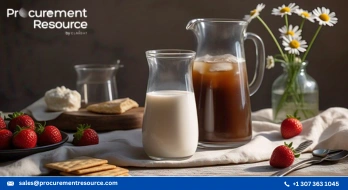India Will Import Butter And Ghee Amid Stagnant Local Supply

Stagnant Milk Output Leads India To Import Dairy Products
India might look to import dairy products, including ghee and butter, in case there is a supply disruption for the products as a result of stagnant milk output last year, reported a leading government official.
Following the assessment of milk's stock position in Southern states where the flushing season began, the government will interfere with sourcing dairy products from outside the country, the source stated, adding that the milk production of the country has been inactive in 2022-23 because of the lumpy skin disease in cattle which killed 1.89 lakh cattle last year.
Request Access For Regular Price Update of Butter
The after-effects of the spread of lumpy skin disease on cattle caused so much havoc that complete milk production witnessed stagnation. Usually, milk output is noticing a 6 percent growth per year. But this year, the percentage is looking bleak and might grow at a rate of 1-2 percent.
Between 2021-22, the country's milk production came to 221 million tonnes, whilst it was 208 million tonnes last year, as per official data.
As the government took the milk production data into account, it included the cooperative sector but only some of the private and unorganised sectors, which means it will be stagnant.
Rajesh Kumar Singh, the Animal Husbandry and Dairy Secretary, stated notified that the regional demand rose by 8-10% during the same time due to a revival in the post-pandemic demand.
According to the source, there is no restraint in the supply of milk in the country; there is a sufficient inventory of skimmed milk powder (SMP). However, regarding dairy products, specifically butter, fats, and ghee, among others, the stakes are lower compared to a year ago.
But, Singh noted that dairy products' import might not be advantageous for now since international prices during the recent months are leading companies. They will be evaluating the flush season (peak production) in the rest of the nation and then make a move.
The deficit will be lower in the north of India, where a delay in the lean season has been reported, with temperatures cooling off because of untimely rains for the past 20 days.
Adding to that, it is true that an increase in fodder prices has caused milk inflation. There is an issue with fodder supply since the fodder crop region has stayed inactive for the past four years, whilst the dairy industry has witnessed an annual growth of 6%.
Dairy products were last imported by India in 2011.
Milk Prices Soar
Milk buying is turning costlier in India ad could soon reach an all-time high, compelling the largest producer in the world to ramp up imports and boost supplies while easing the cost of living pressures.
Farmers are scuffling with a rare double whammy: a deadly condition in their cattle named lumpy skin disease as well as a drawdown in market-ready cattle stock following the pandemic delayed breeding.
Prices of milk have already soared to 56 rupees ($0.68) a litre, up by 15% in the last year-the quickest increase in a decade-making it harder for the government to bring down retail inflation lower than the target by the central bank.
The surge in milk prices, along with other essential goods, is anticipated to evolve into a political issue leading into state elections during the year-end.
Read More About Butter Production Cost Reports - REQUEST FREE SAMPLE COPY IN PDF
Any upside risk approaching from the increased prices of milk will pose as a threat, as per the chief economist at India's Kotak Mahindra Bank, Upasna Bhardwaj.
As milk holds a 6.6% weightage in the consumer price index, any hike can cause a practical implication on headline inflation.
According to the Procurement Resource article, India will probably import dairy products like ghee and butter in the current year as a consequence of stagnant milk output in the country. This stagnation came as a result of the lumpy skin disease in cattle, which killed 1.89 lakh cattle last year. Adding to that, an increase in fodder prices has caused milk inflation, and milk has turned pricier in India ad could soon reach an all-time high, compelling the largest producer in the world to ramp up imports and boost supplies while easing the cost-of-living pressures.



.png)